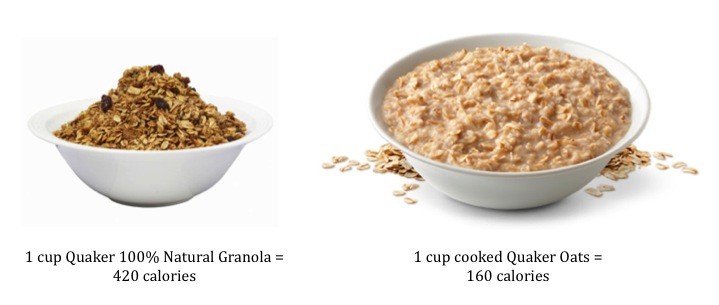If I had the eyes and ears of the world and only 10 minutes to share some of the most important concepts in nutrition, I would attempt to explain nutrient and caloric density. Horrible, horrible names but important ideas. The good news is that the devil is NOT in the details. A broad understanding is all you need to answer most nutrition-related questions.
Before we get into it, I bet these concepts are things you already get intuitively. Let’s see:
Question 1: Both the five Starbursts and medium banana below are about 100 calories. Of these two, which do you think is the healthier choice? Why?
Answer 1: If you guessed the banana, you’d be right. Clearly, there is way more good stuff (vitamins, minerals, phytonutrients, etc.) per calorie in the fruit than in the fruit candy. This is what is termed “nutrient density.”
Question 2: You’re trying to maintain your weight. Would one-cup granola or one-cup oatmeal be the better breakfast choice? Why?
Answer 2: Guess oatmeal? Ding, ding, ding! Considering the same volume of oatmeal has about a third of the calories of granola, you could fill your tummy equally with less calories. This is what is termed “caloric density.”
So, Nutrient Density = the amount of good stuff (vitamins, minerals, phytonutrients, etc.) in a specific food per the amount of calories it provides.
- High nutrient density = lots of good stuff per calorie (aka “superfoods”)
- Low nutrient density = little good stuff per calorie (aka “empty calories”)
And, Caloric Density = the amount of calories in a specific volume/weight of food.
- High caloric density = lots of calories for small amount of food
- Low caloric density = few calories for a large amount of food
Want to see how this should play out on your plate day-to-day?

So now, tell me and be honest, do you get it? Let me know because I am practicing for when I have those 10 minutes of the whole world’s attention.

This makes so much sense, Laura. I especially liked that after you gave the information of the best foods to eat – down to the not good foods to eat – you gave great practical, doable examples of eating. I was so surprised that even whole grain pastas weren’t up in the “great” foods area. Thanks for these inspiring tips!
So glad you found this info useful Kathy! Yes, whole grain pasta can be a healthy addition to a meal, but it shouldn’t be the base of a meal like fruits and vegetables and other foods with both low energy density AND high nutrient density (the kind you can eat with abandon). When I make/eat pasta, I always bulk it out with as many vegetables as I can so I still get to have what looks like a big portion without it being a “empty” calorie bomb. Better yet, choose even less processed whole grains like farro, brown rice or wheatberries the majority of the time. When it comes to grains, the less processed the better because, while it doesn’t change the energy density, it DOES increase the nutrient density. xoxo